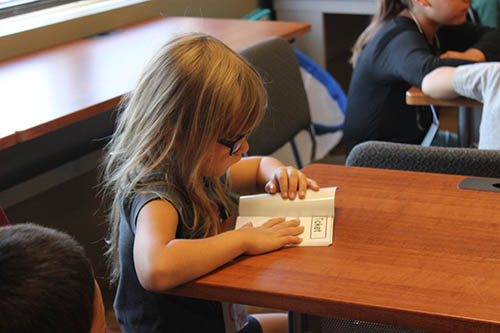Last updated: December 27, 2017
Lesson Plan
Invasive Species Children's Storybook

- Grade Level:
- Middle School: Sixth Grade through Eighth Grade
- Subject:
- Science
- Lesson Duration:
- 90 Minutes
- Common Core Standards:
- 6-8.RST.1, 6-8.RST.7, 8.SL.1, 8.SL.4
- Additional Standards:
- MS-LS2-1
MS-LS2-2
MS-LS-4
Objective
Students begin this activity listening to a children’s storybook that teaches them about a science concept. They will then be challenged to use their creativity to write a children’s story that young children could read to learn about invasive species. In the process of writing the book, their understanding of invasive species and their impact on the environment will be further enhanced.
Background
There are many different ways that we are able to learn—watching videos, reading textbooks, listening to a speaker, or gathering information through experimentation. Students begin this activity listening to a children’s storybook that teaches them about a science concept. They will then be challenged to use their creativity to write a children’s story that young children could read to learn about invasive species. In the process of writing the book, their understanding of invasive species and their impact on the environment will be further enhanced. For the extension activity, students are given the opportunity to read their books to children in a lower grade.
If unsure how to proceed in assisting students in writing a children’s book, there are many websites that might help you in expressing what is important in writing a children’s picture book. An option would be to collaborate with a language arts teacher or your media specialist on this assignment. Depending on your resources, students can produce a hand-written or digital copy of a storybook. There are some websites that allow students to write a book and print. Check with your IT (Information Technology) person to see if your school district has online options for producing books.
Preparation
30-60 minutes to review activity, collect materials, and run off paper copies; 60 minutes to find children’s books to use an examples
Materials
Attachment 1
Download Invasive Species 2: Children's Storybook
Attachment 2
Download Invasive Species 2: Children's Storybook
Lesson Hook/Preview
(10-15 minutes)
Read a children’s book that conveys a scientific idea. There are many different types of books to choose. Find one that is entertaining and fun to get students excited about writing their own book. If you need some suggestions, talk to your media specialist, local bookstore or a primary grades teacher. After reading the book, discuss things that make reading a children’s book fun—engaging pictures and story, easy to read, informative but not too long. Explain they are going to be writing a book that embodies those things to teach children about some aspect of invasive species.
Procedure
(Multiple Days)
1. It is important to have many children’s books in your room during this activity to give students ideas and an understanding of what you are looking for in a book. If you are able to take a trip to the children’s section of a library where they could look at many different types of children’s books, that would give them a good base of what is important when writing a children’s book. Talk to your media specialist and see if he/she would give a presentation to the students on children’s books. Students could bring books from home that were there favorite books to read or they feel are good examples of children’s stories. Try to tap into their “joy of reading” memories from when they were younger.
2. The amount of time given in the classroom to complete their books will impact how many days this assignment will require for completion. You can determine how much time to give to each aspect of this assignment. Broken down into sections, they include: (1) time to read and browse different children’s books, (2) class discussion about what makes a good children’s book and how can a book be written educating children about invasive species, (3) time to complete a sequencing graphic organizer outlining their story, (4) actual work time writing and illustrating a book, (5) practicing reading to peers before reading to younger children, and (6) reading their book to young children. In Attachment 1, “Invasive Species 2: Children’s Storybook”, you will find some guidelines to help students create a book with all the important parts.
A sequencing graphic organizer is available for students to plan out their books in Attachment 2, “Invasive Species 2: Children’s Storybook”. There is space for the planning of five pages on a sheet. Two sheets per student would give them the ability to plan out a ten-page storybook. If writing during class time, be sure and include time for peer review and comments about their books as they are being written.
Vocabulary
invasive species
Assessment Materials
Explanation and ExtensionExplanation:
(Time will vary)
It is important to take the time to model and practice reading books to children. An animated and interesting reader will capture children’s attention and it will be more successful in conveying your message. Break students into small groups to practice reading their stories to their classmates.
Extension:
(Time will vary)
Students will read their stories that they wrote to a student in a younger grade. If the opportunity is not there to visit a classroom as a group and read to younger students, students could read their books to a younger brother / sister or neighbor.
Additional Resources
Created By:
Mary Klass, Geological Society of America, Geocorps America Program; Retired Poudre School District, Fort Collins, CO, Science Teacher
Featured Photo: NPS Photo/S. Sparhawk
Related Lessons or Education Materials
Invasive Species Go-Around (Invasive Species #1)
Invasive Species Raising Awarenss (Invasive Species #3)
